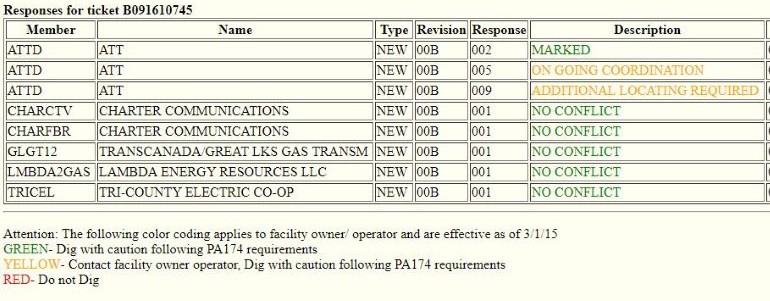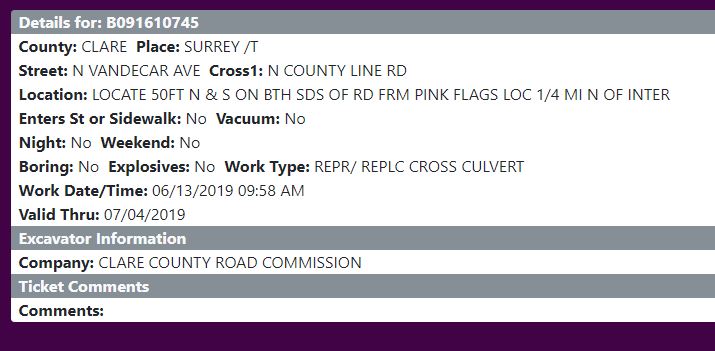Are you planning your next DIY outdoor project? What do projects like building a new deck, putting up a fence or installing a sprinkler system all have in common? They all require digging. To protect you and your home call “Miss Dig” before you start. This should be part of your planning for all outdoor projects.
There can be a lot of planning that goes into some outdoor DIY projects. Where exactly is it going to go? How big is it going to be? What materials am I going to us? Do I have all the right tools for the job? These are all great questions to be asking yourself, but you should consider some other items.
Where do our utility power and gas lines come into the house? Where does the water line run? Is the septic system in this area? Do you have power and/or some of these other utilities running to another building? Knowing where all these utilities are is very important when planning and installing any outdoor project.
What Is Miss Dig?
Table of Contents
Miss Dig is a “one-call system”, usually a third party company, that receives calls from local contractors and homeowners that are planning excavation work in their area. The one-call system then notifies all underground utility company members in that area of the upcoming work. The utility companies then evaluate, locate, mark, and contact the excavation contractors as needed to help ensure the utilities are protected damage.
It’s important to know that the one call centers do not own the utilities and they do not go out and mark the facilities. The one call centers just put excavation contractors, and folks like you, in contact with the utility company owners. And the best thing about this system is it is free to use. And there is no charge when the utility companies locate and mark their lines either.
I am familiar with the on-call system because I worked for a natural gas pipeline company in the state of Michigan, that is based out of Canada. Both the US and Canada have one call systems in place. As you may have guessed, the one-call system in Michigan is called Miss Dig.
Miss Dig is part of a nationwide system in the United States that can be reached by dialing 811 on your phone. Each state’s one call system may have a different name and a few minor requirements, but they’re all focused on putting excavation contractors and homeowners in contact with the underground utility owners and operators.
Michigan’s one call system, Miss Dig, even has applications designed specifically for homeowners. Their “e-Suite” provides some tools and a ton of information for anyone not familiar with the one call system. We’ll explore a couple of the tools below.
Do I Have To Call The One-Call Center Before Digging?

Yes. It is always best to contact your local one-call system before beginning any digging project. In most U.S. states and a few Canadian provinces, there are laws surrounding the excavations over or near underground utilities. The one call systems serve the contractors and utility owners perfectly for this. With one call the contractor can be put in contact with all the utility companies and the process of locating and marking can begin.
You should know that these laws help protect the contractors, homeowners, and utility owners. In most cases, the contractor or homeowner is required to contact the one call system anywhere between 2 and 5 days before digging, depending on where you live and the requirements of your local one call center. This gives the utility companies time to locate and mark their facilities.
Responsibilities Under The Laws
With that said, that also requires the utility companies to mark and respond to the contractors within the waiting period too. Only if there is the potential of the excavation directly affecting an underground utility company facility will there be delays. That’s when the two parties work together to resolve any issues.
Some of the laws can have some pretty stiff penalties for anyone knowingly, and in the case of blatant disregard, damaging underground utilities. There are fines and even jail time that can be applied. You could be responsible for repairs to the underground utilities as well which could run into thousands of dollars.
By using the “one-call system” process everyone is protected. Both from physical and financial harm. Is the system perfect? Probably not, but I know from my experience in the pipeline industry, it is a very good system. I’m sure it has saved many utility outages, injuries and even deaths for those who use it.
Along with the one call system, there are other ways to help identify the presence of underground facilities in the area. Many of them have above ground equipment associated with them or they have signs showing their approximate location. Many electrical services have transformers mounted nearby. Telephone company cables have termination boxes in many locations. Gas lines may have above ground valves and piping. All of these things are clues that underground utilities are in the area. Be sure to reach out to individual companies if needed. It’s worth the effort.
How Do You Use A One-Call System?
Contacting your local one-call system has always been just a phone call away for many years. Today most of the one-call centers have online systems in place making the process even easier. Now the common phrase is “call or click before you dig”. Just do an internet search for the one-call system in your area. For residents in the U.S. and Canada, I found this helpful resource. The “Common Ground Alliance” (CGA) has links and information for all the U.S. states and Canadian provinces one-call systems. It will get you to where you need to be.
To use a one-call system all you need to do is provide them with your contact information and the specific location of where the digging will be done. This information is typical for all one call systems. For best results and a smooth application, it’s always good to collect the information before contacting the one call center. You should also mark the location(s) you plan to dig with “white” flags or spray paint. White markers are an industry standard for marking proposed work areas and will give the utility companies a much clearer idea of your intentions.
Once you make your request a “dig ticket” will be generated and you will be given a “dig ticket number”. Be sure to keep this number. The ticket will be sent to all underground utilities in the area. The individual utility companies are required to investigate, locate, mark, and “respond” to the dig ticket. If your dig location will not affect their facility, they will leave a “positive response” saying you are clear to dig. All of this is tracked and recorded by the one call system.

You must have “positive responses” from all the utilities in the area before you are allowed to begin digging. It is your responsibility to check for the positive responses using your dig ticket number. Once positive responses have been received you can “hand dig” only with caution near the buried utility. In some cases, the utility company will request to be on site while you dig. You should always respect their request and remember there is no cost to you.
If there are issues with the location of your proposed dig site, the utility company will respond, but it will not be positive. They may request more information or inform you there is an issue with the location. If this occurs, you and the facility owners will have to meet and discuss the option for resolving the conflict.
As I’ve said, the requirement for one-call systems in your area may vary. Be sure to follow their requirements. If you have any questions, you should contact the one-call system. They’ll be glad to help.
Information Needed For Michigan’s Miss Dig Request

To see what information you need, get online and go to the one-call center application page, referred to as the “request” page for Miss Dig, and make a list of the information you’ll need. If you know a homeowner without internet access, I’ve included a list of the information requested online at the Michigan Miss Dig site. I’m sure it will be enough information to get them started. Print this article and give it to that friend or family member before they start their next DIY home project. You’ll sleep better knowing you’ve done what you can to help protect them.
There may be a couple more general questions and a place for additional information and comments. This list should be enough to get you started.
Underground Utilities Not Part Of A One Call System

One call systems are great a great tool for locating and protecting “participating members”. Unfortunately, there are some small companies with underground facilities that do not participate in one-call systems. The good news is that most of the major utility companies participate in there local one-call systems. However, you should always try to identify the presence of other utility companies in the area. Looking for additional warning signs along the roads or talking with neighbors is another good way to help identify the presence of underground utilities.
Another area that one call systems cannot help is with underground utilities that are after meters or attach to city utility systems outside of the main road right of ways. In a few cases, their responsibilities end at the customer’s property lines. Water and sewer systems are examples of this in some areas. Be sure to account for all utilities for your home before beginning your project.
Other utilities one call systems are not responsible for are those that the homeowner has installed themselves. Locating power, gas or water lines that were run to a pole barn or other buildings on your property is strictly the homeowner’s responsibility.
If you have no record of the locations of these types of facilities, there are private companies that specialize in locating underground utilities that can be hired. Unfortunately, the costs of locating these utilities are also the responsibility of the homeowner. When trying to decide whether to pay for such services don’t forget to factor in the possibility of injury, along with the costs of replacing any damaged cables or pipes.
What Are The Hazards Of Hitting Underground Utilities?

Damaging any underground utility has hazards associated with them ranging from minor disruptions all the way up to life-threatening. But don’t forget… after listening to your family complain about not having cable TV or internet access for a couple of days, you may wish you were in the hospital. Seriously, we shouldn’t take any of these risks too lightly. Maybe you have a security system or a health alert system that requires a phone line or internet connection to send for help. Even seemingly minor disruption can have huge negative effects for some. Everyone’s situation is different.
In the case of electricity or gas lines, the risks just got elevated significantly! Now you’re talking about electrocution and fire or explosions. Even the lower voltages and pressure entering the home can cause significant damage or injury. Gas from just a small leak in a gas line can migrate into the home and accumulate until it finds an ignition source and then BOOM!

Or maybe you’re installing a mailbox post or a new fence along the road in front of your home. These areas are where the utility “main lines” run and they often have higher voltages and pressures. In this article written by John Fossen, featured on the DTE Energy website, he tells the story of an individual digging a hole with a pair of hand-operated posthole diggers that hit a 7,200-volt primary electrical cable running on his property. The homeowner thought he hit a tree root, so he kept digging at it until he broke through the coating on the cable. The resulting arc flash caused burns to his arms and face, damaged nearby cable TV equipment, and started a small grass fire. Needless to say, this person was very lucky to only have sustained minor injuries.
City water systems can be dangerous as well. If a water line is hit while you’re trenching in a dog fence or putting in that sprinkler system you’ve always wanted, the water in these systems can blow dirt and debris 50’ to 100’ in the air. That kind of force can cause serious injury.
Even small leaks in water lines or sewer lines can eventually lead to washouts and sinkholes. Issues like this can lead to home foundation damage and basement flooding. These types of damages can run into the thousands of dollars to repair. So remember, your actions could affect you, your home, and the homes and lives of your neighbors.
Conclusion
When it comes to DIY home projects we’ve always stressed safety. We have written blog articles about “wearing personal protective equipment” and using “lockout/tagout”. Wearing the right safety equipment and using safe work practices are key to completing any home repairs or projects without injuries. And don’t forget to call Miss Dig or to use your local on-call system. It’s another great way to help prevent injuries when working on outdoor projects.
Seemingly innocent tasks like driving in the stakes for one of those large tents for parties in the backyard can put you at risk. Or building a bonfire pit over a plastic gas line has the potential for serious injuries. So before you begin any outdoor project, be sure to make sure contacting your local one-call system is part of your planning process.
If you have any comments or questions, you can leave them in the comments section below or you can email us at [email protected]. FYI, we do not collect or share email addresses. We will only use them to reply to your comments or provide answers to your questions. We are also required to let you know that some of our links are “affiliate links”. This means if you click on a link and make a purchase, we could make a small commission, at no extra cost to you. This helps offset the cost of maintaining our website. So, if you like what you’ve seen, please be sure to give us a “Like” and “Share” on Facebook and Instagram too. Thank you for reading and good luck with all your home projects!


Thank you for helping me to understand [that it is important to get positive responses from utilities before digging in the ground. I need to install a sprinkler system in my yard. I need to get some professional help so that I don’t break any utilities that are in the ground.